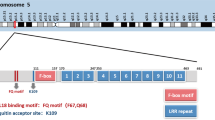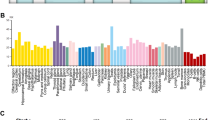Abstract
The identification of novel tumor-associated genes represents an important area of cancer research. To that end, we have discovered a number of genes whose expression is altered in breast tumors. One of these genes has been identified as the ring finger protein 11 (RNF11) and its expression is elevated in breast and prostate cancer. The RNF11 gene encodes a 154 amino-acid protein that contains a ring finger and a PY motif. RNF11 is capable of binding numerous proteins, which encompass a wide variety of cellular pathways and mechanisms. This gives RNF11 a corresponding breadth of functions, including involvement in TGF-β and epidermal growth factor receptor (EGFR) signaling. In addition, RNF11 has the potential to mediate the ubiquitination and subsequent proteolysis of many cellular proteins. Thus, it may represent an important target of novel cancer therapies.
This is a preview of subscription content, access via your institution
Access options
Subscribe to this journal
Receive 50 print issues and online access
$259.00 per year
only $5.18 per issue
Buy this article
- Purchase on Springer Link
- Instant access to full article PDF
Prices may be subject to local taxes which are calculated during checkout




Similar content being viewed by others
References
Asao H, Sasaki Y, Arita T, Tanaka N, Endo K, Kasai H, Takeshita T, Endo Y, Fujita T and Sugamura K . (1997). J. Biol. Chem., 272, 32785–32791.
Aravind L and Koonin EV . (2000). Curr. Biol., 10, R132–R134.
Bache KG, Raiborg C, Mehlum A and Stenmark H . (2003). J. Biol. Chem., 278, 12513–12521.
Ben-Izhak O, Lahav-Baratz S, Meretyk S, Ben-Eliezer S, Sabo E, Dirnfeld M, Cohen S and Ciechanover A . (2003). J. Urol., 170, 241–245.
Boehmer C, Okur F, Setiawan I, Broer S and Lang F . (2003). Biochem. Biophys Res. Commun., 306, 156–162.
Brés V, Kiernan RE, Linares LK, Chable-Bessia C, Plechakova O, Tréand C, Emiliani S, Peloponese JM, Jeang KT, Coux O, Scheffner M and Benkirane M . (2003). Nat. Cell Biol., 5, 754–761.
Burger AM, Zhang X and Seth A . (1998). Eur. J. Cancer Prev., 1, S29–S35.
Catzavelos C, Bhattacharya N, Ung YC, Wilson JA, Roncari L, Sandhu C, Shaw P, Yeger H, Morava-Protzner I, Kapusta L, Franssen E, Pritchard KI and Slingerland JM . (1997). Nat. Med., 3, 227–230.
Catzavelos C, Tsao MS, DeBoer G, Bhattacharya N, Shepherd FA and Slingerland JM . (1999). Cancer Res., 59, 684–688.
Confalonieri S, Salcini AE, Puri C, Tacchetti C and Di Fiore PP . (2000). J. Cell Biol., 150, 905–912.
Coopman PJ, Do MT, Barth M, Bowden ET, Hayes AJ, Basyuk E, Blancato JK, Vezza PR, McLeskey SW, Mangeat PH and Mueller SC . (2000). Nature, 406, 742–747.
Datta SR, Brunet A and Greenberg ME . (1999). Genes Dev., 13, 2905–2927.
Donovan J and Slingerland J . (2000). Breast Cancer Res., 2, 116–124.
Fang S, Jensen JP, Ludwig RL, Vousden KH and Weissman AM . (2000). J. Biol. Chem., 275, 8945–8951.
Fang S, Lorick KL, Jensen JP and Weissman AM . (2003). Semin. Cancer Biol., 13, 5–14.
Fukuchi M, Fukai Y, Masuda N, Miyazaki T, Nakajima M, Sohda M, Manda R, Tsukada K, Kato H and Kuwano H . (2002). Cancer Res., 15, 7162–7165.
Gillessen S, Groettup M and Cerny T . (2002). Onkologie, 25,534–539.
Gilmore PM, Quinn JE, Mullan PB, Andrews HN, McCabe N, Carty M, Kennedy RD and Harkin DP . (2003). Biochem. Soc. Trans., 31, 257–262.
Gstaiger M, Jordan R, Lim M, Catzavelos C, Mestan J, Slingerland J and Krek W . (2001). Proc. Natl. Acad. Sci. USA, 98, 5043–5048.
Hatakeyama S and Nakayama K-I . (2003). Biochem. Biophys. Res. Commun., 302, 635–645.
Hatakeyama S, Yada M, Matsumoto M, Ishida N and Nakayama K-I . (2001). J. Biol. Chem., 276, 33111–33120.
Hayashi H, Abdollah S, Qiu Y, Cai J, Xu YY, Grinnell BW, Richardson MA, Topper JN, Gimbrone Jr MA, Wrana JL and Falb D . (1997). Cell, 89, 1165–1173.
Itoh F, Asao H, Sugamura K, Heldin CH, ten Dijke P and Itoh S . (2001). EMBO J., 20, 4132–4142.
Joazeiro CAP and Weissman AM . (2000). Cell, 102, 549–552.
Jolliffe CN, Harvey KF, Haines BP, Parasivam G and Kumar S . (2000). Biochem. J., 351, 557–565.
Kavsak P, Rasmussen RK, Causing CG, Bonni S, Zhu H, Thomsen GH and Wrana JL . (2001). Mol. Cell, 6, 1365–1375.
Kitching R, Wong MJ, Koehler D, Burger A, Landberg G, Gish G and Seth A . (2003). Biochim. Biophys. Acta. 1639, 104–112.
Kretzschmar M . (2000). Breast Cancer Res., 2, 107–115.
Li H-X and Seth A . (2003). Oncogene. (in press).
Liang J, Zubovitz J, Petrocelli T, Kotchetkov R, Connor MK, Han K, Lee JH, Ciarallo S, Catzavelos C, Beniston R, Franssen E and Slingerland JM . (2002). Nat. Med., 8, 1153–1160.
Liu X, Sun Y, Weinberg RA and Lodish HF . (2001). Cytokine Growth Factor Rev., 12, 1–8.
Massague J, Blain SW and Lo RS . (2000). Cell, 103, 295–309.
Medrano EE . (2003). Oncogene, 22, 3123–3129.
Mehra A and Wrana JL . (2002). Biochem Cell Biol., 80, 605–622.
Michael D and Oren M . (2002). Semin. Cancer Biol., 13, 49–58.
Miyazono K, Suzuki H and Imamura T . (2003). Cancer Sci., 94, 230–234.
Momand J, Jung D, Wilczynski S and Niland J . (1998). Nucleic Acids Res., 26, 3453–3459.
Monteleone G, Kumberova A, Croft NM, McKenzie C, Steer HW and MacDonald TT . (2001). J. Clin. Invest., 108, 601–609.
Mori N, Morishita M, Tsukazaki T and Yamamoto N . (2003). Int. J. Cancer, 105, 661–668.
Moynahan ME . (2002). Oncogene, 21, 8994–9007.
Mustelin T and Tasken K . (2003). Biochem. J., 371, 15–27.
Nakao A, Afrakhte M, Moren A, Nakayama T, Christian JL, Heuchel R, Itoh S, Kawabata M, Heldin NE, Heldin CH and ten Dijke P . (1997). Nature, 389, 631–635.
Nalepa G and Harper JW . (2003). Cancer Treat. Rev., 29, 49–57.
Peng H, Zheng L, Lee W-H, Rux JJ and Rauscher III FJ . (2002). Cancer Res., 62, 3773–3781.
Pray TR, Parlati F, Huang J, Wong BR, Payan DG, Bennett MK, Issakani SD, Molineaux S and Demo SD . (2002). Drug Resist. Update, 5, 249–258.
Rosen EM, Fan S, Pestell RG and Goldberg ID . (2003). J. Cell Physiol., 196, 19–41.
Sakamoto KM . (2002). Mol. Genet Metab., 77, 44–56.
Seki N, Hattori A, Hayashi A, Kozuma S, Sasaki M, Suzuki Y, Sugano S, Muramatsu MA and Saito T . (1999). Biochim. Biophys. Acta, 1489, 421–427.
Shigemasa K, Gu L, O'Brien TJ and Ohama K . (2003). Clin. Cancer Res., 9, 1756–1763.
Shin I, Yakes FM, Rojo F, Shin NY, Bakin AV, Baselga J and Arteaga CL . (2002). Nat. Med., 8, 1145–1152.
Slingerland J and Pagano M . (2000). J. Cell Physiol., 183, 10–17.
Subramanium V, Li H-X, Wong M, Kitching R, Attisano L, Wrana J, Zubovits J, Burger AM and Seth A . (2003). Br. J. Cancer, 89, 1538–1544.
Sun Y, Liu X, Ng-Eaton E, Lodish HF and Weinberg RA . (1999). Proc. Natl. Acad. Sci. USA, 96, 12442–12447.
Tanaka N, Kaneko K, Asao H, Kasai H, Endo Y, Fujita T, Takeshita T and Sugamura K . (1999). J. Biol. Chem., 274, 19129–19135.
Viglietto G, Motti ML, Bruni P, Melillo RM, D'Alessio A, Califano D, Vinci F, Chiappetta G, Tsichlis P, Bellacosa A, Fusco A and Santoro M . (2002). Nat. Med., 8, 1136–1144.
Weissman AM . (2001). Nat. Rev. Mol. Cell Biol., 2, 169–178.
Winberg G, Matskova L, Chen F, Plant P, Rotin D, Gish G, Ingham R, Ernberg I and Pawson T . (2000). Mol. Cell. Biol., 20, 8526–8535.
Xu J and Attisano L . (2000). Proc. Natl. Acad. Sci. USA, 97, 4820–4825.
Yanagi S, Inatome R, Takano T and Yamamura H . (2001). Biochem. Biophys. Res. Commun., 288, 495–498.
Zheng L, Pan H, Li S, Flesken-Nikitin A, Chen PL, Boyer TG and Lee W-H . (2000). Mol. Cell, 6, 757–768.
Acknowledgements
This work is supported by a post-doctoral fellowship to MKC from the US Department of Defense Breast Cancer Research Program and Canadian Breast Cancer Research Alliance grants and a CIHR grant (MOP37784) to AS.
Author information
Authors and Affiliations
Corresponding author
Rights and permissions
About this article
Cite this article
Connor, M., Seth, A. A central role for the ring finger protein RNF11 in ubiquitin-mediated proteolysis via interactions with E2s and E3s. Oncogene 23, 2089–2095 (2004). https://doi.org/10.1038/sj.onc.1207380
Published:
Issue Date:
DOI: https://doi.org/10.1038/sj.onc.1207380
Keywords
This article is cited by
-
RNF135, RING finger protein, promotes the proliferation of human glioblastoma cells in vivo and in vitro via the ERK pathway
Scientific Reports (2016)
-
Ubiquitination involved enzymes and cancer
Medical Oncology (2014)
-
The ubiquitin-editing enzyme A20 requires RNF11 to downregulate NF-κB signalling
The EMBO Journal (2009)



